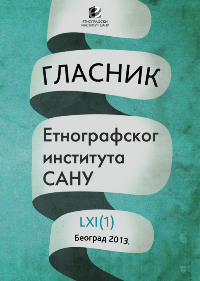(Де)конструкција женског тијела у Еурипидовом 'Хиполиту'
(De)construction of a Female Body in Euripides' Hippolytus
Author(s): Đurđina Šijaković MaidanikSubject(s): Anthropology
Published by: Етнографски институт САНУ
Keywords: Euripides (cca 480–406 BC); Phaedra; woman; body; δύστροπος ἁρμονία; the self and the other; eros and dialog
Summary/Abstract: Ancient Greek theatre and theatre in general, offering a special experience of reality, uses body as its medium to a great extent. At the same time, body is the sovereign of the stage, it benefits from its own possibilities and the possibilities of the text, scene, tendance of the audience. When it comes to tragedy, paradoxically enough, it possesses the greatest power and attracts the highest attention when it reaches the limits of its strength, when it walks on the edge, when it experiences labor, pain, suffering, and even death. Female body has been, and not only in ancient times, perceived as more fragile, open, susceptible to influences, more prone and inclined to experiences such as pleasure and pain. This perception is one of dimensions of a complex polarity in which woman takes place of the other. The conflict between male and female character is in the focus of dramatic action very often: in the opus of Euripides in a way which is maybe the closest to the contemporary audience and readers. This paper has taken as its case study Euripides’ drama Hippolitus, which characterizes a woman as a δύστροπος ἁρμονία. This „reversed, disonant harmony“ is placed within a female body. Biological limitations force a female being to adapt, mutate, to be at odds with her very self – that is how her inner conflict and ambiguity appear. In reading the chosen tragedy, philological and anthropological will encounter together with the perspectives of gender and culture studies. The here offered reading of Hippolitus is given with the awareness of the struggle for body (or against it) in the XXI century. Contemporary anthropology, other social sciences and humanities prominently aim their attention towards social and cultural dimensions of the body’s existence. Medicine and sport vest in the body a media dimension, being concern with its limitations. On the other hand, the today body has increasingly been an object of interpretations, decoding, studying, virtualization, reading and re-reading, and decreasingly an object (and even subject) of reception and experience by the means of sences. On the trail of “somatosophic” thought that the body is an agent for accomplishing interchange, communication, dialog, that eros beholds a dialogical nature as its most distinctive feature, and that there is a desire for dialog in the essence of an erotic desire, it could be said that Euripides’ Phaedra longed for interchange and communication, for understanding and empathy – for eros as dialog. This cry and this desire were placed within a female body which witnessed, with its condition, decadent process and finally dissolution, a non-fulfillment of the essential need.
Journal: Гласник Етнографског института САНУ
- Issue Year: LXI/2013
- Issue No: 1
- Page Range: 59-74
- Page Count: 14
- Language: Serbian

